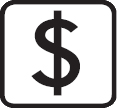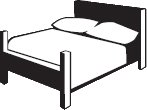

TOP REASONS TO GO
 Eye candy: Pick just about any trail in the park and it’s all but guaranteed to culminate in an astounding viewpoint full of pink, orange, and crimson rock formations.
Eye candy: Pick just about any trail in the park and it’s all but guaranteed to culminate in an astounding viewpoint full of pink, orange, and crimson rock formations.
 Auto immunity: From spring through autumn, cars are generally not allowed in Zion Canyon, allowing for a quiet and peaceful park.
Auto immunity: From spring through autumn, cars are generally not allowed in Zion Canyon, allowing for a quiet and peaceful park.
 Botanical wonderland: Zion Canyon is home to approximately 900 species of plants, more than anywhere else in Utah.
Botanical wonderland: Zion Canyon is home to approximately 900 species of plants, more than anywhere else in Utah.
 Animal tracks: Zion has expansive hinterlands where furry, scaly, and feathered residents are common. Hike long enough and you’ll encounter deer, elk, rare lizards, birds of prey, and other zoological treats.
Animal tracks: Zion has expansive hinterlands where furry, scaly, and feathered residents are common. Hike long enough and you’ll encounter deer, elk, rare lizards, birds of prey, and other zoological treats.
 Unforgettable canyoneering: Zion’s array of rugged slot canyons is the richest place on Earth for scrambling, rappelling, climbing, and descending.
Unforgettable canyoneering: Zion’s array of rugged slot canyons is the richest place on Earth for scrambling, rappelling, climbing, and descending.

 Zion Canyon. This area defines Zion National Park for most people. Free shuttle buses are the only vehicles allowed during the crowded high season. The backcountry is accessible via the West Rim Trail and the Narrows, and 2,000-foot cliffs rise all around.
Zion Canyon. This area defines Zion National Park for most people. Free shuttle buses are the only vehicles allowed during the crowded high season. The backcountry is accessible via the West Rim Trail and the Narrows, and 2,000-foot cliffs rise all around.
 The Narrows. A quintessential slot canyon, this is one of the national park system’s best hiking trails. Following the north fork of the Virgin River, there’s something for everyone in the Narrows, whether you’re a day-tripper or an overnight explorer.
The Narrows. A quintessential slot canyon, this is one of the national park system’s best hiking trails. Following the north fork of the Virgin River, there’s something for everyone in the Narrows, whether you’re a day-tripper or an overnight explorer.
 Kolob Canyons. The northwestern corner of Zion is a secluded 30,000-acre wonderland that can be reached only via a special entrance. Don’t miss the West Temple and the Kolob Arch, and keep looking up to spot Horse Ranch Mountain, the park’s highest point.
Kolob Canyons. The northwestern corner of Zion is a secluded 30,000-acre wonderland that can be reached only via a special entrance. Don’t miss the West Temple and the Kolob Arch, and keep looking up to spot Horse Ranch Mountain, the park’s highest point.
 Lava Point. Infrequently visited, this area has a primitive campground and two nearby reservoirs that offer the only significant fishing opportunities. Lava Point Overlook provides a view of Zion Canyon from the north.
Lava Point. Infrequently visited, this area has a primitive campground and two nearby reservoirs that offer the only significant fishing opportunities. Lava Point Overlook provides a view of Zion Canyon from the north.
GETTING ORIENTED
The heart of Zion National Park is Zion Canyon, which follows the North Fork of the Virgin River for 6½ miles beneath cliffs that rise 2,000 feet from the river bottom. The Kolob area is considered by some to be superior in beauty, and because it’s isolated from the rest of the park, you aren’t likely to run into any crowds here. Both sections hint at the extensive backcountry beyond, open for those with the stamina, time, and the courage to go off the beaten path.
Updated by John Blodgett
The walls of Zion Canyon soar more than 2,000 feet above the valley below, but it’s the character, not the size, of the sandstone forms that defines the park’s splendor. Throughout the park, fantastically colored bands of limestone, sandstone, and lava in the strata point to the distant past. Stripes and spots of greenery high in the cliff walls create a “hanging garden” effect, and invariably indicate the presence of water seepage or a spring. Erosion has left behind a collection of domes, fins, and blocky massifs bearing the names and likenesses of cathedrals and temples, prophets and angels.
Trails lead deep into side canyons and up narrow ledges to waterfalls, serene spring-fed pools, and shaded spots of solitude. So diverse is this place that 85% of Utah’s flora and fauna species are found here. Some, like the tiny Zion snail, appear nowhere else in the world.
The Colorado River helped create the Grand Canyon, while the Virgin River—the Colorado’s muddy progeny—carved Zion’s features. Because of the park’s unique topography, distant storms and spring runoff can transform a tranquil slot canyon into a sluice.
WHEN TO GO
Zion is the most heavily visited national park in Utah, receiving 3 million visitors each year. Locals used to call the spring and fall the shoulder seasons because traffic would drop off from the highly visited summer months. Not so much anymore. These days the park is busy from April through October.
Summer in the park is hot and dry, punctuated by sudden cloudbursts that can create flash flooding and spectacular waterfalls. Expect afternoon thunderstorms between July and September. Whether the day starts out sunny or not, wear sunscreen and drink lots of water, even if you aren’t exerting yourself or spending much time outside. The sun is very powerful at this elevation.
Winters are mild at lower desert elevations. You can expect to encounter winter driving conditions from November to mid-March, and although most park programs are suspended in winter, it is a wonderful and solitary time to see the canyons.
 TIP → The temperature in Zion often exceeds 100°F in July and August.
TIP → The temperature in Zion often exceeds 100°F in July and August.

FESTIVALS AND EVENTS
JANUARY
St. George Winter Bird Festival. Bird-watchers gather in St. George every January to peep at more than 100 feathered species. Join in three full days of field trips, exhibits, lectures, and activities.  Tonaquint Park and Nature Center, 1851 S. Dixie Dr., St. George
Tonaquint Park and Nature Center, 1851 S. Dixie Dr., St. George  435/868–8756, 435/673–0996
435/868–8756, 435/673–0996  www.sgcity.org
www.sgcity.org  $10.
$10.
AUGUST
Western Legends Roundup. FAMILY For three days in late August, Kanab plays host to cowboy poets, musicians, and character actors from Old West TV series of yesteryear. A parade, tours to Western movie sites, a dutch-oven dinner, a quilt show, performances by Native American dancers, and a film festival draw visitors from all over the country.  435/644–3444
435/644–3444  westernlegendsroundup.com.
westernlegendsroundup.com.
SEPTEMBER
Dixie Roundup. Dozens of professional rodeo cowboys from across the West take part in this three-day mid-September event held since the 1930s. Team roping, saddle-bronc riding, and bull riding are among the main attractions, along with the always entertaining mutton-busting competition for the kids and the rodeo parade.  Sun Bowl Stadium, St. George
Sun Bowl Stadium, St. George  435/703–4779
435/703–4779  stgeorgelions.com
stgeorgelions.com  $10.
$10.
GETTING HERE AND AROUND
AIR TRAVEL
The nearest commercial airport is 46 miles away in St. George, Utah. McCarran International Airport (LAS) in Las Vegas, Nevada, 170 miles away, is the nearest large airport. Salt Lake City’s airport is 310 miles away.
CAR TRAVEL
Zion National Park lies east of Interstate 15 in southwestern Utah. From the interstate, head east on Highway 9. After 21 miles you’ll reach Springdale, which abuts the main entrance.
From mid-March through October, you can drive into the park only if you have reservations at the Zion Lodge. Otherwise, you must park your car in Springdale or at the Zion Canyon Visitor Center and take the shuttle. There are no car restrictions from November to mid-March.
The Zion Canyon Visitor Center parking lot fills up quickly. You can avoid parking heartburn by leaving your car in Springdale and riding the shuttle to the park entrance. Shuttles are accessible for people with disabilities and have plenty of room for gear. Consult the print park guide or check online at  www.nps.gov/zion/planyourvisit/shuttle-system.htm for the town shuttle schedule.
www.nps.gov/zion/planyourvisit/shuttle-system.htm for the town shuttle schedule.
PARK ESSENTIALS
ACCESSIBILITY
Both visitor centers, all shuttle buses, and Zion Lodge are fully accessible to people in wheelchairs. Several campsites (sites A24 and A25 at Watchman Campground and sites 103, 114, and 115 at South Campground) are reserved for people with disabilities, and two trails—Riverside Walk and Pa’rus Trail—are accessible with some assistance.
PARK FEES AND PERMITS
Entrance to Zion National Park costs $30 per vehicle for a seven-day pass. People entering on foot or by bicycle pay $15 per person for a seven-day pass; those on motorcycle pay $25.
Permits are required for backcountry camping and overnight hikes. Depending on which parts of the trails you intend to explore, you’ll need a special permit for the Narrows and Kolob Creek or the Subway slot canyon. Climbing and canyoneering parties need a permit before using technical equipment.
Zion National Park limits the total number of overnight and canyoneering permits issued per day and has a reservation system with most of the permits now issued in an online lottery to apportion them fairly. Permits to the Subway, Mystery Canyon, the Narrows through-hikes, and West Rim are in short supply during high season. The maximum size of a group hiking into the backcountry is 12 people. Permits cost $15 for one or two people; $20 for three to seven; and $25 for eight or more. Permits are available at the visitor centers.
PARK HOURS
The park, open daily year-round, 24 hours a day, is in the Mountain time zone.
CELL-PHONE RECEPTION
Cell-phone reception is good in Springdale but spotty in Zion Canyon. Public telephones can be found at South Campground, Watchman Campground, Zion Canyon Visitor Center, Zion Lodge, and Zion Human History Museum.
EDUCATIONAL OFFERINGS
CLASSES AND SEMINARS
Zion Natl Park Forever Project. Formerly known as the Zion Natural History Association, the project conducts workshops about the park’s natural and cultural history. Topics can include edible plants, bat biology, river geology, photography, and bird-watching. Most workshops include a hike. For a glimpse of Zion’s inner workings, volunteer to assist with one of their ongoing projects.  Zion National Park
Zion National Park  435/772–3264, 800/635–3959
435/772–3264, 800/635–3959  www.zionpark.org
www.zionpark.org  From $45.
From $45.
RANGER PROGRAMS
Evening Programs. Held each evening May through September in Watchman Campground and at Zion Lodge, these 45-minute ranger-led talks cover geology, biology, and history. You might learn about coyote calls, the night sky, animal hideouts, or observing nature with all your senses. Slide shows and audience participation are often part of the proceedings. Check the park guide and visitor center for times, locations, and topics.  Zion National Park
Zion National Park  435/772–3256
435/772–3256  www.nps.gov/zion
www.nps.gov/zion  Free.
Free.
Fodor’sChoice Expert Talks. Informal lectures take place on the Zion Human History Museum patio. Past topics have included wildlife, geology, and the stories of early settlers. Talks usually last from 20 to 30 minutes, though some run longer. Park bulletin boards and publications have schedules.
Expert Talks. Informal lectures take place on the Zion Human History Museum patio. Past topics have included wildlife, geology, and the stories of early settlers. Talks usually last from 20 to 30 minutes, though some run longer. Park bulletin boards and publications have schedules.  Zion National Park
Zion National Park  435/772–3256
435/772–3256  Free.
Free.
Junior Ranger Program. FAMILY Educational activities aimed at younger visitors include the chance to earn a Junior Ranger badge. Kids do so by attending at least one nature program and completing the free Junior Ranger Handbook, available at visitor centers and elsewhere. The ranger-led programs cover topics such as plants, animals, geology, and archaeology through hands-on activities, games, and hikes.  Zion National Park
Zion National Park  435/772–3256
435/772–3256  www.nps.gov/kids/jrRangers.cfm
www.nps.gov/kids/jrRangers.cfm  Free.
Free.
Ranger-Led Hike. A daily guided hike along the 2-mile Watchman Trail provides an overview of the park’s geology and natural and other history. Groups meet at 8 am at Zion Canyon Visitor Center. Wear sturdy footgear and bring a hat, sunglasses, sunscreen, and water.  Zion National Park
Zion National Park  www.nps.gov/zion/planyourvisit/ranger-led-activities.htm
www.nps.gov/zion/planyourvisit/ranger-led-activities.htm  Free.
Free.
Fodor’sChoice Ride with a Ranger Shuttle Tours. FAMILY Once a day, rangers conduct shuttle tours of points of interest along Zion Canyon Scenic Drive. In addition to learning about the canyon’s geology, ecology, and history, you’ll be treated to some great photo ops. The 90-minute tour takes place in the morning and departs from the Zion Canyon Visitor Center. Seating is limited to eight people. Make reservations in person at the visitor center up to three days in advance.
Ride with a Ranger Shuttle Tours. FAMILY Once a day, rangers conduct shuttle tours of points of interest along Zion Canyon Scenic Drive. In addition to learning about the canyon’s geology, ecology, and history, you’ll be treated to some great photo ops. The 90-minute tour takes place in the morning and departs from the Zion Canyon Visitor Center. Seating is limited to eight people. Make reservations in person at the visitor center up to three days in advance.  Zion Canyon Visitor Center
Zion Canyon Visitor Center  435/772–3256
435/772–3256  www.nps.gov/zion
www.nps.gov/zion  Free
Free  Closed Nov.–Mar.
Closed Nov.–Mar.
RESTAURANTS
Only one full-service restaurant operates within the park, but there are numerous choices just beyond it. Springdale is the best choice for family-friendly restaurants.
HOTELS
The Zion Lodge is rustic but clean and comfortable. Springdale has dozens of lodging options, from quaint bed-and-breakfasts to modest motels to chain hotels with riverside rooms. Panguitch and Hurricane have some good options for budget and last-minute travelers. Hotel reviews have been shortened. For full information, visit Fodors.com.

VISITOR INFORMATION
Park Contact Information Zion National Park.  Hwy. 9, Springdale
Hwy. 9, Springdale  435/772–3256
435/772–3256  nps.gov/zion.
nps.gov/zion.
VISITOR CENTERS
Kolob Canyons Visitor Center. Make this your first stop as you enter this remote section of the park. There are books and maps, a small gift shop, and clean restrooms here, and rangers are on hand to answer questions about Kolob Canyons exploration.  3752 E. Kolob Canyon Rd., Exit 40 off I–15
3752 E. Kolob Canyon Rd., Exit 40 off I–15  435/586–9548
435/586–9548  www.nps.gov/zion.
www.nps.gov/zion.
Zion Canyon Visitor Center. Learn about the area’s geology, flora, and fauna at an outdoor exhibit next to a gurgling stream. Inside, a large shop sells everything from field guides to souvenirs. Zion Canyon shuttle buses leave regularly from the center and make several stops along the canyon’s beautiful scenic drive; ranger-guided shuttle tours depart once a day April to October.  Zion Park Blvd. at south entrance, Springdale
Zion Park Blvd. at south entrance, Springdale  435/772–3256
435/772–3256  www.nps.gov/zion.
www.nps.gov/zion.
Driving is the only way to easily access Kolob Canyon, and from November through March it’s the only way to access the Zion Canyon Scenic Drive.
Kolob Canyons Road. The beauty starts modestly at the junction with Interstate 15, but as you move along this 5-mile road the red walls of the Kolob finger canyons rise suddenly and spectacularly out of the earth. With the crowds left behind at Zion Canyon, this drive offers the chance to take in incredible vistas at your leisure. Trails include the short but rugged Middle Fork of Taylor Creek Trail, which passes two 1930s homestead cabins, culminating 2¾ miles later in the Double Arch Alcove. During heavy snowfall Kolob Canyons Road may be closed.  I–15, Exit 40.
I–15, Exit 40.
Kolob Terrace Road. This 22-mile road begins 14 miles west of Springdale at Virgin and winds north to Kolob Reservoir. The drive meanders in and out of the park boundaries, crossing several important trailheads, all the while overlooking the cliffs of North Creek. A popular day-use trail (permit required) leads past fossilized dinosaur tracks to the Subway, a stretch of the stream where the walls of the slot canyon close in so tightly as to form a near tunnel. Farther along the road you reach the Wildcat Canyon trailhead, which connects to the path overlooking the North Guardian Angel. The road terminates at the reservoir, beneath 8,933-foot Kolob Peak. This narrow, twisting road is not recommended for RVs. Because of limited winter plowing, the road is closed from December through April or May.  Zion National Park
Zion National Park  Drive begins at Hwy. 9 and Kolob Terrace Rd. in Virgin
Drive begins at Hwy. 9 and Kolob Terrace Rd. in Virgin  Closed Dec.–Apr. or May.
Closed Dec.–Apr. or May.
Zion Canyon Scenic Drive. Vividly colored cliffs tower 2,000 feet above the road that meanders north from Springdale along the floor of Zion Canyon. As you roll through the narrow, steep canyon you’ll pass the Court of the Patriarchs, the Sentinel, and the Great White Throne, among other imposing rock formations. Unless you’re staying at the lodge, Zion Canyon Scenic Drive is accessed only by park shuttle from mid-March through October. You can drive it yourself at other times.  Zion Park Blvd./Hwy. 9.
Zion Park Blvd./Hwy. 9.
Zion–Mount Carmel Highway and Tunnels. Two narrow tunnels as old as the park itself lie between the east entrance and Zion Canyon on this breathtaking 24-mile (round-trip) stretch of Highway 9. One was once the longest man-made tunnel in the world. As you travel the (1.1-mile) passage through solid rock, five arched portals along one side provide fleeting glimpses of cliffs and canyons. When you emerge you’ll find that the landscape has changed dramatically. Large vehicles require traffic control and a $15 permit, available at the park entrance, and have restricted hours of travel. This includes nearly all RVs, trailers, dual-wheel trucks, and campers. The Canyon Overlook Trail starts from a parking area between the tunnels.  Hwy. 9, 5 miles east of Canyon Junction.
Hwy. 9, 5 miles east of Canyon Junction.
Zion Human History Museum. This quaint museum tells the park’s story from the perspective of its human inhabitants, among them Ancestral Puebloans and early Mormon settlers. Permanent exhibits illustrate how humans have dealt with wildlife, plants, and natural forces. Temporary exhibits include finds from recent archaeological excavations. Don’t miss the incredible view of Towers of the Virgin from the back patio.  Zion Canyon Scenic Dr., ½ mile north of south entrance
Zion Canyon Scenic Dr., ½ mile north of south entrance  435/772–3256
435/772–3256  www.nps.gov/zion/historyculture/zion-human-history-museum.htm
www.nps.gov/zion/historyculture/zion-human-history-museum.htm  Free
Free  Closed after Thanksgiving–mid-Mar.
Closed after Thanksgiving–mid-Mar.
Fodor’sChoice Zion Lodge. Architect Gilbert Stanley Underwood, responsible for many noteworthy national park lodges, designed the original Zion Lodge, which opened in the 1920s but was destroyed by fire four decades later. In 1990, it was restored to its original rustic style, in some cases down to the very paint color. Natural beauty is on display inside and out, from the lobby’s rock columns and exposed wood to the cottonwoods shading the sprawling lawn. The main building includes a gift shop, a fine-dining restaurant, and a snack bar. The lodge has received numerous awards for its eco-friendly practices. Recent amenities include bike rentals, open-air narrated tram rides, and an electric-vehicle charging station.
Zion Lodge. Architect Gilbert Stanley Underwood, responsible for many noteworthy national park lodges, designed the original Zion Lodge, which opened in the 1920s but was destroyed by fire four decades later. In 1990, it was restored to its original rustic style, in some cases down to the very paint color. Natural beauty is on display inside and out, from the lobby’s rock columns and exposed wood to the cottonwoods shading the sprawling lawn. The main building includes a gift shop, a fine-dining restaurant, and a snack bar. The lodge has received numerous awards for its eco-friendly practices. Recent amenities include bike rentals, open-air narrated tram rides, and an electric-vehicle charging station.  Zion Canyon Scenic Dr.
Zion Canyon Scenic Dr.  435/772–7700.
435/772–7700.
The park comprises two distinct sections, Zion Canyon and the Kolob Plateau and Canyons. Most people restrict their visit to the better-known Zion Canyon, but the Kolob area has much to offer and should not be missed if time allows. Though there’s little evidence of Kolob’s beauty from the entrance point off Interstate 15, once you negotiate the first switchback on the park road, you are hit with a vision of red-rock cliffs shooting out of the earth. As you climb in elevation, you are treated first to a journey through these canyons, then to a view into the chasm.  TIP → Because you must exit the park to get from Zion Canyon to Kolob Canyon, it is not easy to explore both sections in one day.
TIP → Because you must exit the park to get from Zion Canyon to Kolob Canyon, it is not easy to explore both sections in one day.
Checkerboard Mesa. It’s well worth stopping at the pull-out 1 mile west of Zion’s east entrance to observe the distinctive waffle patterns on this huge white mound of sandstone. The stunning crosshatch effect visible today is the result of eons of freeze-and-thaw cycles that caused vertical fractures, combined with erosion that produced horizontal bedding planes.  Zion–Mount Carmel Hwy.
Zion–Mount Carmel Hwy.
Court of the Patriarchs. This trio of peaks bears the names of, from left to right, Abraham, Isaac, and Jacob. Mount Moroni is the reddish peak on the far right that partially blocks the view of Jacob. Hike the trail that leaves from the Court of the Patriarchs Viewpoint, 1½ miles north of Canyon Junction, to get a much better view of the sandstone prophets; you may catch a glimpse of rock climbers camming their way up Isaac’s sheer face.  Zion Canyon Scenic Dr.
Zion Canyon Scenic Dr.
Great White Throne. Dominating the Grotto picnic area near Zion Lodge, this massive Navajo sandstone peak juts 2,000 feet above the valley floor. The popular formation lies about 3 miles north of Canyon Junction.  Zion Canyon Scenic Dr.
Zion Canyon Scenic Dr.
Fodor’sChoice The Narrows. This sinuous 16-mile crack in the earth where the Virgin River flows over gravel and boulders is one of the world’s most stunning gorges. If you hike through it, you’ll find yourself surrounded—sometimes nearly boxed in—by smooth walls stretching high into the heavens. Plan to get wet.
The Narrows. This sinuous 16-mile crack in the earth where the Virgin River flows over gravel and boulders is one of the world’s most stunning gorges. If you hike through it, you’ll find yourself surrounded—sometimes nearly boxed in—by smooth walls stretching high into the heavens. Plan to get wet.  Zion National Park
Zion National Park  Begins at Riverside Walk.
Begins at Riverside Walk.
Weeping Rock. Surface water from the rim of Echo Canyon spends several thousand years seeping down through the porous sandstone before exiting at this picturesque alcove 4½ miles north of Canyon Junction. A paved walkway climbs ¼ mile to this flowing rock face where wildflowers and delicate ferns grow. In fall, the maples and cottonwoods burst with color, and lizards point the way down the path, which is not suitable for wheelchairs.  Zion Canyon Scenic Dr.
Zion Canyon Scenic Dr.
Hiking is by far the most popular activity at Zion, with all sorts of trails leading to rewarding hinterland destinations: extreme slot canyons, gorgeous overlooks, verdant meadows, and dripping springs. Some sections of the Virgin River are ideal for canoeing (inner tubes are not allowed). In winter, hiking boots can be exchanged for snowshoes and cross-country skis, but check with a ranger to determine backcountry snow conditions.
Zion National Park has something for every kind of biker. Mountain bikers can cake themselves with mud on the park’s trails, and racers will find enough up and down to make their pulses race.
Zion has taken steps to become much more bicycle-friendly, including having bike racks at some of the facilities and on the shuttle buses themselves. If you are renting bikes by the hour from a Springdale outfitter, you can load your bike on the bus, have the shuttle take you to the last stop (Temple of Sinawava), and take an easy one-way pedal back to Springdale.  TIP → When you’re on the park road, shuttle buses and cars have the right of way. You’re expected to pull off to the side and let them pass.
TIP → When you’re on the park road, shuttle buses and cars have the right of way. You’re expected to pull off to the side and let them pass.
Within the park proper, bicycles are allowed only on established park roads and the 3½-mile Pa’rus Trail, which winds along the Virgin River in Zion Canyon. You cannot walk or ride your bicycle through the Zion–Mount Carmel tunnels; the only way to get your bike past this stretch of the highway is to transport it by motor vehicle.  www.nps.gov/zion/planyourvisit/bicycling.htm
www.nps.gov/zion/planyourvisit/bicycling.htm
TOURS AND OUTFITTERS
Bicycles Unlimited. A trusted southern Utah mountain-biking resource, this shop rents bikes and sells parts, accessories, and guidebooks.  90 S. 100 E, St. George
90 S. 100 E, St. George  435/673–4492
435/673–4492  bicyclesunlimited.com
bicyclesunlimited.com  From $25 for 4 hrs.
From $25 for 4 hrs.
Zion Cycles. This shop rents bikes by the hour or longer, sells parts, and has a full-time mechanic on duty. You can pick up trail and other advice from the staff here.  868 Zion Park Blvd., Springdale
868 Zion Park Blvd., Springdale  435/772–0400
435/772–0400  zioncycles.com
zioncycles.com  From $26 for 4 hrs.
From $26 for 4 hrs.
The best way to experience Zion Canyon is to walk beneath, between and, if you can bear it (and have good balance!), along its towering cliffs. Trails vary, from paved and flat river strolls to precarious cliffside scrambles. Whether you’re heading out for a day of rock hopping or an hour of meandering, pack and consume plenty of drinking water to counteract the effects of a high-altitude workout in the arid climate.
Keeping the sun at bay is a real challenge at Zion National Park. Put on sunscreen before you set out, and reapply at regular intervals. Because the park’s hikes usually include uneven surfaces and elevation changes, wear sturdy shoes or hiking boots. Many veteran hikers carry good walking sticks, too, as they’re invaluable along trails that ford or follow the Virgin River or its tributaries.
Zion is one of the most popular parks in the country, so it can be hard to envision just how alone you’ll be on some of the less traveled trails. If you want to do a backcountry hike, make a reservation. Let park rangers know where you’re going and when you plan to return.
 TIP → Park rangers warn hikers to remain on alert for flash floods; these walls of water can appear out of nowhere, even when the sky above you is clear. You can learn more about hiking safety and obtain a trail map at the visitor centers or online (
TIP → Park rangers warn hikers to remain on alert for flash floods; these walls of water can appear out of nowhere, even when the sky above you is clear. You can learn more about hiking safety and obtain a trail map at the visitor centers or online ( www.nps.gov/zion/planyourvisit/hiking-in-zion.htm).
www.nps.gov/zion/planyourvisit/hiking-in-zion.htm).
EASY
Emerald Pools Trail. FAMILY Multiple waterfalls cascade (or drip, in dry weather) into algae-filled pools along this trail, about 3 miles north of Canyon Junction. The path leading to the lower pool is paved and appropriate for strollers and wheelchairs. If you’ve got any energy left, keep going past the lower pool. The ¼ mile from there to the middle pool becomes rocky and steep but offers increasingly scenic views. A less crowded and exceptionally enjoyable return route follows the Kayenta Trail, connecting to the Grotto Trail. Allow 50 minutes for the 1¼-mile round-trip hike to the lower pool, and an hour more each round-trip to the middle (2 miles) and upper pools (3 miles). Lower, easy. Upper, moderate.  Zion National Park
Zion National Park  Trailhead: at Zion Canyon Scenic Dr.
Trailhead: at Zion Canyon Scenic Dr.
Grotto Trail. FAMILY This flat trail takes you from Zion Lodge, about 3 miles north of Canyon Junction, to the Grotto picnic area, traveling for the most part along the park road. Allow 20 minutes or less for the walk along the ½-mile trail. If you are up for a longer hike and have two or three hours, connect with the Kayenta Trail after you cross the footbridge, and head for the Emerald Pools. You will begin gaining elevation, and it’s a steady, steep climb to the pools, which you will begin to see after about 1 mile. Easy.  Zion National Park
Zion National Park  Trailhead: at Zion Canyon Scenic Dr.
Trailhead: at Zion Canyon Scenic Dr.
Pa’rus Trail. An approximately 2-mile, relatively flat paved walking and biking path, Pa’rus parallels and occasionally crosses the Virgin River. Starting at South Campground, ½ mile north of the south entrance, the walk proceeds north along the river to the beginning of Zion Canyon Scenic Drive. Along the way you’ll take in great views of the Watchman, the Sentinel, the East and West temples, and Towers of the Virgin. Leashed dogs are allowed on this trail. Wheelchair users may need assistance. Easy.  Zion National Park
Zion National Park  Trailhead: at Canyon Junction.
Trailhead: at Canyon Junction.
Riverside Walk. FAMILY This 2-mile round-trip hike shadows the Virgin River. In spring, wildflowers bloom on the opposite canyon wall in lovely hanging gardens. The trail, which begins 6½ miles north of Canyon Junction at the end of Zion Canyon Scenic Drive, is the park’s most visited trail, so be prepared for crowds in high season. Riverside Walk is paved and suitable for strollers and wheelchairs, though some wheelchair users may need assistance. Round-trip it takes about 90 minutes. At the end, the Narrows Trail begins. Easy.  Zion National Park
Zion National Park  Trailhead: at Temple of Sinawava shuttle stop, Zion Canyon Scenic Dr.
Trailhead: at Temple of Sinawava shuttle stop, Zion Canyon Scenic Dr.
MODERATE
Fodor’sChoice Canyon Overlook Trail. FAMILY The parking area just east of Zion–Mount Carmel tunnel leads to this popular trail, which is about 1 mile round-trip and takes about an hour to finish. From the overlook at the trail’s end you can see the West and East temples, the Towers of the Virgin, the Streaked Wall, and other Zion Canyon cliffs and peaks. The elevation change is 160 feet. Moderate.
Canyon Overlook Trail. FAMILY The parking area just east of Zion–Mount Carmel tunnel leads to this popular trail, which is about 1 mile round-trip and takes about an hour to finish. From the overlook at the trail’s end you can see the West and East temples, the Towers of the Virgin, the Streaked Wall, and other Zion Canyon cliffs and peaks. The elevation change is 160 feet. Moderate.  Zion National Park
Zion National Park  Trailhead: at Hwy. 9, east of Zion–Mount Carmel tunnel.
Trailhead: at Hwy. 9, east of Zion–Mount Carmel tunnel.
Taylor Creek Trail. This trail in the Kolob Canyons area descends parallel to Taylor Creek, sometimes crossing it, sometimes shortcutting benches beside it. The historic Larsen Cabin precedes the entrance to the canyon of the Middle Fork, where the trail becomes rougher. After the old Fife Cabin, the canyon bends to the right into Double Arch Alcove, a large, colorful grotto with a high blind arch (or arch “embryo”) towering above. To Double Arch it’s 2¾ miles one-way—about four hours round-trip. The elevation change is 440 feet. Moderate.  Zion National Park
Zion National Park  Trailhead: at Kolob Canyons Rd., about 1½ miles east of Kolob Canyons Visitor Center.
Trailhead: at Kolob Canyons Rd., about 1½ miles east of Kolob Canyons Visitor Center.
Watchman Trail. For a view of Springdale and a look at lower Zion Creek Canyon and the Towers of the Virgin, this strenuous hike begins on a service road east of Watchman Campground. Some springs seep out of the sandstone, nourishing the hanging gardens and attracting wildlife. There are a few sheer cliff edges, so supervise children carefully. Plan on two hours for this 3-mile round-trip hike that has a 380-foot elevation change. Moderate.  Zion National Park
Zion National Park  Trailhead: at Zion Canyon Visitor Center.
Trailhead: at Zion Canyon Visitor Center.
DIFFICULT
Angels Landing Trail. As much a trial as a trail, this path beneath the Great White Throne is one of the park’s most challenging hikes. Early on you work your way through Walter’s Wiggles, a series of 21 switchbacks built out of sandstone blocks. From there you traverse sheer cliffs that have chains bolted into the rock face to serve as handrails in some (but not all) places. In spite of its hair-raising nature, this trail is popular. Allow 2½ hours round-trip if you stop at Scout’s Lookout (2 miles), and four hours if you keep going to where the angels (and birds of prey) play. The trail is 5 miles round-trip and is not appropriate for children. Difficult.  Zion National Park
Zion National Park  Trailhead: at Zion Canyon Scenic Dr., about 4½ miles north of Canyon Junction.
Trailhead: at Zion Canyon Scenic Dr., about 4½ miles north of Canyon Junction.
Fodor’sChoice Narrows Trail. The hike on the Narrows Trail is a stunning and unique nature experience, but it’s no picnic. After leaving the paved ease of the Gateway to the Narrows trail behind, the real fun begins. Rather than following a trail or path, you walk on the riverbed itself. In places you’ll find a pebbly shingle or dry sandbar path, but when the walls of the canyon close in, you’ll be forced into the chilly waters of the Virgin River, walking against the current—tack back and forth, don’t fight it head-on. A walking stick and shoes with good tread and ankle support are highly recommended and will make hiking the riverbed much more enjoyable. Be prepared to swim, as chest-deep holes may occur even when water levels are low. Like any narrow desert canyon, this one is famous for sudden flash flooding, even when skies are clear. Before hiking into the Narrows, check with park rangers about the likelihood of flash floods. A day trip up the lower section of the Narrows is 6 miles one-way to the turnaround point. Allow at least five hours round-trip. Difficult.
Narrows Trail. The hike on the Narrows Trail is a stunning and unique nature experience, but it’s no picnic. After leaving the paved ease of the Gateway to the Narrows trail behind, the real fun begins. Rather than following a trail or path, you walk on the riverbed itself. In places you’ll find a pebbly shingle or dry sandbar path, but when the walls of the canyon close in, you’ll be forced into the chilly waters of the Virgin River, walking against the current—tack back and forth, don’t fight it head-on. A walking stick and shoes with good tread and ankle support are highly recommended and will make hiking the riverbed much more enjoyable. Be prepared to swim, as chest-deep holes may occur even when water levels are low. Like any narrow desert canyon, this one is famous for sudden flash flooding, even when skies are clear. Before hiking into the Narrows, check with park rangers about the likelihood of flash floods. A day trip up the lower section of the Narrows is 6 miles one-way to the turnaround point. Allow at least five hours round-trip. Difficult.  Zion National Park
Zion National Park  Trailhead: at end of Riverside Walk.
Trailhead: at end of Riverside Walk.
TOURS AND OUTFITTERS
Canyon Trail Rides. FAMILY Grab your hat and boots and see Zion Canyon the way the pioneers did—on a horse or mule. Easygoing, one-hour and half-day guided rides are available (minimum age 7 and 10 years, respectively). Maximum weight is 220 pounds. These friendly folks have been around for years, and are the only outfitter for trail rides inside the park. Reservations are recommended and can be made online.  Across from Zion Lodge
Across from Zion Lodge  435/772–3810
435/772–3810  canyonrides.com
canyonrides.com  From $45.
From $45.
Swimming is allowed in the Virgin River, but be careful of cold water, slippery rock bottoms, and the occasional flash floods when it rains. Swimming isn’t permitted in the Emerald Pools. The use of inner tubes is prohibited within park boundaries, but some companies offer trips on a Virgin River tributary just outside the park.
Cross-country skiing and snowshoeing are best experienced in the park’s higher elevations in winter, where snow stays on the ground longer. Inquire at the Zion Canyon Visitor Center for backcountry conditions. Snowmobiling is allowed only for residential access.
Coral Pink Sand Dunes State Park. Visitors to this sweeping expanse of pink sand enjoy a slice of nature produced by eroding sandstone. Funneled through a notch in the rock, wind picks up speed and carries grains of sand into the area. Once the wind slows down, the sand is deposited, creating this giant playground for dune buggies, ATVs, and dirt bikes. A small area is fenced off for walking, but the sound of wheeled toys is always with you. Children love to play in the sand, but check the surface temperature; it can become very hot. Off-road vehicles must have current registration.  Coral Sand Dunes Rd./Hwy. 43, 12 miles west of U.S. 89, off Hancock Rd., Kanab
Coral Sand Dunes Rd./Hwy. 43, 12 miles west of U.S. 89, off Hancock Rd., Kanab  435/648–2800
435/648–2800  stateparks.utah.gov
stateparks.utah.gov  $8.
$8.
Maynard Dixon Living History Museum. Two miles north of Mount Carmel Junction, this was the final residence of the famous painter of Western life and landscapes. The property and log cabin structure are now maintained by the nonprofit Thunderbird Foundation for the Arts. Tours are self-guided or, from mid-March to mid-November, you can call ahead to arrange a docent tour.  U.S. 89, mile marker 84, Mount Carmel
U.S. 89, mile marker 84, Mount Carmel  435/648–2653
435/648–2653  thunderbirdfoundation.com
thunderbirdfoundation.com  $10; $20 for docent tour.
$10; $20 for docent tour.
Snow Canyon State Park. Named not for winter weather but after a pair of pioneering Utahans named Snow, this gem of a state park is filled with natural wonders. Hiking trails lead to lava cones, sand dunes, cactus gardens, and high-contrast vistas. From the campground you can scramble up huge sandstone mounds and overlook the entire valley. Park staff lead occasional guided hikes. The park is about 10 miles northwest of St. George, and about an hour from Zion.  1002 Snow Canyon Dr., Ivins
1002 Snow Canyon Dr., Ivins  435/628–2255
435/628–2255  stateparks.utah.gov
stateparks.utah.gov  $6 per vehicle.
$6 per vehicle.
 Castle Dome Café & Snack Bar. $ CAFÉ Next to the shuttle stop at Zion Lodge, this small fast-food restaurant is all about convenience. You can grab a banana, burger, smoothie, or salad to go, or while away an hour with ice cream on the shaded patio. Known for: quick bites; bustling scene; family friendly.
Castle Dome Café & Snack Bar. $ CAFÉ Next to the shuttle stop at Zion Lodge, this small fast-food restaurant is all about convenience. You can grab a banana, burger, smoothie, or salad to go, or while away an hour with ice cream on the shaded patio. Known for: quick bites; bustling scene; family friendly.  Average main: $6
Average main: $6  Zion Canyon Scenic Dr., 3¼ miles north of Canyon Junction
Zion Canyon Scenic Dr., 3¼ miles north of Canyon Junction  435/772–7700
435/772–7700  zionlodge.com/dining.
zionlodge.com/dining.
 Red Rock Grill. $$ AMERICAN The fare at this restaurant at Zion Lodge includes steaks, seafood, and Western specialties such as trout and bison meat loaf headlining the dinner menu. Photos of the surrounding landscape adorn the walls of the spacious dining room, and the large patio has gorgeous views of the real thing. Known for: dinner reservations necessary in summer; outdoor seating; canyon setting.
Red Rock Grill. $$ AMERICAN The fare at this restaurant at Zion Lodge includes steaks, seafood, and Western specialties such as trout and bison meat loaf headlining the dinner menu. Photos of the surrounding landscape adorn the walls of the spacious dining room, and the large patio has gorgeous views of the real thing. Known for: dinner reservations necessary in summer; outdoor seating; canyon setting.  Average main: $18
Average main: $18  Zion Lodge, Zion Canyon Scenic Dr.
Zion Lodge, Zion Canyon Scenic Dr.  435/772–7760
435/772–7760  zionlodge.com/dining.
zionlodge.com/dining.
PICNIC AREAS
The Grotto. FAMILY Get your food to go at the Zion Lodge, take a short walk to this lunch retreat, and dine beneath a shady oak. The amenities include drinking water, picnic tables, and restrooms, but there are no fire grates. A trail from here leads to the Emerald Pools.  Zion Canyon Scenic Dr.
Zion Canyon Scenic Dr.
Kolob Canyons Viewpoint. Enjoy a shaded meal with a view at this picnic site 100 yards down the Timber Creek Trail, 5 miles from Kolob Canyons Visitor Center.  Zion National Park
Zion National Park  On Timber Creek Trail at end of Kolob Canyons Rd.
On Timber Creek Trail at end of Kolob Canyons Rd.
Zion Nature Center. FAMILY On your way to or from the Junior Ranger Program you can feed your kids at the center’s picnic area. When the center is closed, use the restrooms in South Campground.  Zion Canyon Scenic Dr.
Zion Canyon Scenic Dr.  Near entrance to South Campground, ½ mile north of south entrance
Near entrance to South Campground, ½ mile north of south entrance  435/772–3256.
435/772–3256.
 Bit & Spur. $$ SOUTHWESTERN This laid-back Springdale institution has been serving locals and tourists for more than 30 years. The well-rounded menu includes fresh fish and pasta dishes, but the emphasis is on creative Southwestern fare such as roasted-sweet-potato tamales and chili-rubbed rib-eye steak. Known for: innovative margaritas; live music; signature rib eye.
Bit & Spur. $$ SOUTHWESTERN This laid-back Springdale institution has been serving locals and tourists for more than 30 years. The well-rounded menu includes fresh fish and pasta dishes, but the emphasis is on creative Southwestern fare such as roasted-sweet-potato tamales and chili-rubbed rib-eye steak. Known for: innovative margaritas; live music; signature rib eye.  Average main: $20
Average main: $20  1212 Zion Park Blvd., Springdale
1212 Zion Park Blvd., Springdale  435/772–3498
435/772–3498  www.bitandspur.com
www.bitandspur.com  No lunch.
No lunch.
 Sol Foods Supermarket. $ DELI Stop by the market’s deli and check out the premade sandwiches and abundant salad bar, or order a quick sandwich, wrap, or vegetarian snack of your choice. The staff can also prepare a box lunch for your day in the park. Known for: box lunches; extensive menu; one-stop shop.
Sol Foods Supermarket. $ DELI Stop by the market’s deli and check out the premade sandwiches and abundant salad bar, or order a quick sandwich, wrap, or vegetarian snack of your choice. The staff can also prepare a box lunch for your day in the park. Known for: box lunches; extensive menu; one-stop shop.  Average main: $8
Average main: $8  995 Zion Park Blvd., Springdale
995 Zion Park Blvd., Springdale  435/772–3100
435/772–3100  www.solfoods.com.
www.solfoods.com.
BEST CAMPGROUNDS IN ZION
The two campgrounds within Zion National Park—South and Watchman—are family-friendly, convenient, and pleasant, but in high season they fill up fast. Outside Zion are the park-affiliated Lava Point campground and some private campgrounds.
South Campground. All the sites here are under big cottonwood trees that provide some relief from the summer sun. The campground operates on a first-come, first-served basis, and sites are usually filled before noon each day during high season.  Hwy. 9, ½ mile north of south entrance
Hwy. 9, ½ mile north of south entrance  435/772–3256.
435/772–3256.
Watchman Campground. This large campground on the Virgin River operates on a reservation system between April and October, but you do not get to choose your site.  Access road off Zion Canyon Visitor Center parking lot
Access road off Zion Canyon Visitor Center parking lot  435/772–3256, 800/365–2267
435/772–3256, 800/365–2267  www.recreation.gov.
www.recreation.gov.
 Spotted Dog Café. $$ ECLECTIC This restaurant is more upscale than most in Springdale, but its staff makes patrons feel right at home even if they saunter in wearing hiking shoes. The exposed wood beams and large windows that frame the surrounding trees and rock cliffs set a Western mood, with tablecloths and original artworks supplying a dash of refinement. Known for: locally roasted coffee; sidewalk dining; breakfast buffet.
Spotted Dog Café. $$ ECLECTIC This restaurant is more upscale than most in Springdale, but its staff makes patrons feel right at home even if they saunter in wearing hiking shoes. The exposed wood beams and large windows that frame the surrounding trees and rock cliffs set a Western mood, with tablecloths and original artworks supplying a dash of refinement. Known for: locally roasted coffee; sidewalk dining; breakfast buffet.  Average main: $20
Average main: $20  Flanigan’s Inn, 428 Zion Park Blvd., Springdale
Flanigan’s Inn, 428 Zion Park Blvd., Springdale  435/772–0700
435/772–0700  www.flanigans.com/dining
www.flanigans.com/dining  Limited hrs Nov.–Mar. No lunch.
Limited hrs Nov.–Mar. No lunch.
 The Switchback Grille. $$$ AMERICAN Known for its USDA prime steaks and seafood flown in fresh daily, the high-ceilinged Switchback has walls of windows framing stunning views. Like all good steak houses, it serves comforting sides such as roasted potatoes and sautéed mushrooms. Known for: aged beef; casual elegance; seafood specials.
The Switchback Grille. $$$ AMERICAN Known for its USDA prime steaks and seafood flown in fresh daily, the high-ceilinged Switchback has walls of windows framing stunning views. Like all good steak houses, it serves comforting sides such as roasted potatoes and sautéed mushrooms. Known for: aged beef; casual elegance; seafood specials.  Average main: $25
Average main: $25  Holiday Inn Express, 1149 S. Zion Park Blvd., Springdale
Holiday Inn Express, 1149 S. Zion Park Blvd., Springdale  435/772–3700
435/772–3700  switchbackgrille.com
switchbackgrille.com  No lunch.
No lunch.
 Zion Lodge. $$$$ HOTEL If location is your key concern, you’d be hard-pressed to improve on a stay at the historic Zion Lodge: the canyon’s jaw-dropping beauty surrounds you, access to trailheads is easy, and guests can drive their cars in the park year-round. Pros: guests can drive their cars in the park year-round; incredible views; bike rentals on-site. Cons: pathways are dimly lit (bring a flashlight); Wi-Fi and cell reception can be spotty; sells out months ahead for summer.
Zion Lodge. $$$$ HOTEL If location is your key concern, you’d be hard-pressed to improve on a stay at the historic Zion Lodge: the canyon’s jaw-dropping beauty surrounds you, access to trailheads is easy, and guests can drive their cars in the park year-round. Pros: guests can drive their cars in the park year-round; incredible views; bike rentals on-site. Cons: pathways are dimly lit (bring a flashlight); Wi-Fi and cell reception can be spotty; sells out months ahead for summer.  Rooms from: $227
Rooms from: $227  Zion Canyon Scenic Dr.
Zion Canyon Scenic Dr.  888/297–2757 reservations only, 435/772–7700
888/297–2757 reservations only, 435/772–7700  zionlodge.com
zionlodge.com  82 rooms, 40 cabins
82 rooms, 40 cabins  No meals.
No meals.